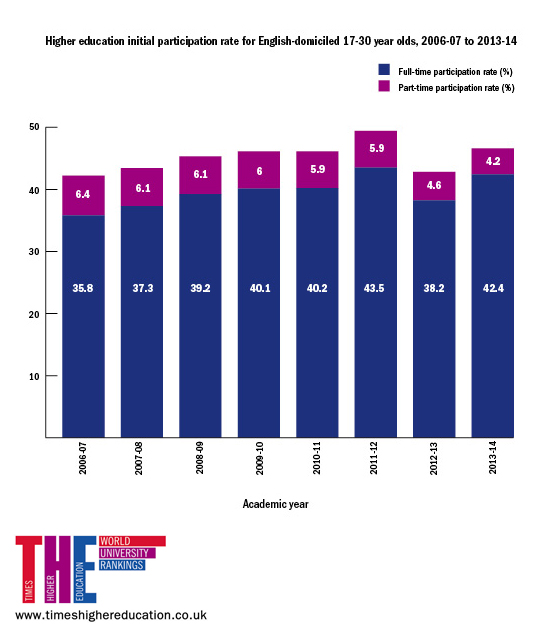Higher education participation rates have bounced back after dropping sharply following the introduction of £9,000 undergraduate tuition fees, official statistics show.
A report published by the Department for Business, Innovation and Skills put England’s higher education participation rate in 2013-14 at 46.6 per cent. This was “more in line” with the general upward trend in participation that was disrupted by the introduction of fees, the paper says.
The participation rate, an estimate of the proportion of people aged 17 to 30 who have enrolled on a higher education course at a university or college, had climbed slowly past 46 per cent in the years prior to 2011-12.
That year, it shot up to 49.3 per cent, as students chose not to defer entry in order to avoid paying £9,000-a-year fees, which were introduced in 2012-13. This put the participation rate within touching distance of the target, set by Tony Blair’s government, of 50 per cent of young people proceeding to higher study.
However, the inevitable consequence of the reduction in deferrals was that the participation rate slumped in 2012-13, to 42.9 per cent.

Les Ebdon, director of the Office For Fair Access, described the return to an upward trend as “excellent news”.
“It shows that young people continue to see the value of higher education,” Professor Ebdon said.
But the data also confirm a continuing drop in the proportion of people aged between 17 and 30 studying part-time, with this participation rate falling to 4.2 per cent in 2013-14, compared to 4.6 per cent the previous year. In 2006-07, the part-time participation rate was 6.4 per cent.
When people aged between 17 and 60 are considered, the part-time participation rate now stands at 7.2 per cent, half the 2006-07 figure and down 1.3 per cent year-on-year.
Dave Phoenix, chair of the Million+ group and vice-chancellor of London South Bank University, expressed concern at this trend.
“Unless BIS and the Treasury intervene with positive measures to support the mature and part-time student markets, there is a real risk that they will suffer permanent damage to the detriment of these individuals and the UK,” Professor Phoenix said.
The data also confirm a widening of the gender gap in participation. The participation rate for women aged between 17 and 30 was 51.2 per cent in 2013-14, up 3.9 per cent year-on-year. The corresponding figure for men was 42.1 per cent, up only 3.5 per cent.




